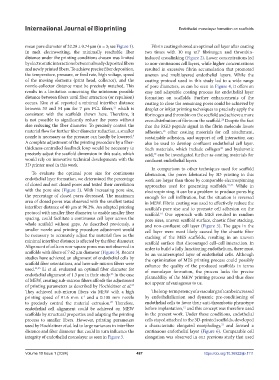Page 495 - IJB-10-1
P. 495
International Journal of Bioprinting Endothelial monolayer formation on scaffolds
mean pore diameter of 32.28 ± 0.74 µm (n = 3; see Figure 1). Fibrin coating showed an optimal cell layer after coating
In melt electrowriting, the minimally reachable fiber two times with 10 mg ml fibrinogen and thrombin-
1
distance under the printing conditions chosen was limited induced crosslinking (Figure 2). Lower concentrations led
by electrostatic interactions between already deposited fibers to non-continuous cell layers, while higher concentrations
and newly printed fibers. To achieve precise fiber deposition, resulted in excessive fibrin accumulation that promoted
the temperature, pressure, or feed rate, high voltage, speed uneven and multilayered endothelial layers. While the
of the moving elements (print head, collector), and the coating protocol used in this study led to a wide range
nozzle-collector distance must be precisely matched. This of pore diameters, as can be seen in Figure 4, it offers an
results in a limitation concerning the minimum possible easy and adaptable coating process for endothelial layer
distance between fibers until fiber attraction (or repulsion) formation on scaffolds. Further enhancements of the
occurs. Kim et al. reported a minimal interfiber distance coating to close the remaining pores could be achieved by
between 33 and 54 µm for 7 µm PCL fibers, which is droplet or inkjet printing techniques to precisely apply the
23
consistent with the scaffolds shown here. Therefore, it fibrinogen and thrombin on the scaffold and achieve a more
is not possible to significantly reduce the pores without even distribution of fibrin on the scaffold. Despite the fact
28
also reducing the fiber diameter. To precisely control the that the RGD peptide signal in the fibrin molecule favors
material flow for further fiber diameter reduction, a smaller adhesion, other coating materials for cell attachment,
16
nozzle is necessary as the pressure can hardly be lowered. sustainable adhesion, and support of cell interaction can
8
A complete adjustment of the printing procedure by a fiber- also be used to develop confluent endothelial cell layer.
thickness-controlled feedback loop would be necessary to Such materials, which include collagen and hyaluronic
29
precisely adjust the scaffold dimension in this scale, which acid, can be investigated further as coating materials for
30
would rely on innovative technical developments with the confluent endothelial layers.
3D printer used in this work.
In comparison to other techniques used for scaffold
To evaluate the optimal pore size for continuous fabrication, the pores fabricated by 3D printing in this
endothelial layer formation, we determined the percentage work are larger than those by comparable electrospinning
of closed and not closed pores and tested their correlation approaches used for generating scaffolds. 31,32 While in
with the pore size (Figure 2). With increasing pore size, electrospinning, it can be a problem to produce pores big
the percentage of closed pores decreased. The maximum enough for cell infiltration, but the situation is reversed
area of closed pores was observed with the smallest tested in MEW. Fibrin coating was used to effectively reduce the
interfiber distance of 40 µm at 96.2%. An adapted printing scaffold’s pore size and to promote cell adhesion on the
protocol with smaller fiber diameter, to enable smaller fiber scaffold. Our approach with MES resulted in random
16
spacing, could facilitate a continuous cell layer across the pore sizes, uneven scaffold surface, chaotic fiber stacking,
whole scaffold without gaps. As described previously, a and non-confluent cell layer (Figure 5). The gaps in the
smaller nozzle and printing procedure adjustment would cell layer were most likely caused by the chaotic fiber
be necessary to accurately adjust the material flow as the stacking of the MES scaffolds, resulting in an uneven
minimal interfiber distance is affected by the fiber diameter. scaffold surface that discouraged cell–cell interaction. In
Alignment of cells on non-square pores was not observed in order to build a fully functioning endothelium, there must
scaffolds with fibers of 7.62 µm diameter (Figure 3). Recent be an uninterrupted layer of endothelial cells. Although
studies have achieved an alignment of endothelial cells by the optimization of MES printing process could possibly
scaffold fiber orientations, and here sub-micron fibers were enhance the quality of the produced scaffolds in terms
used. 24,25 Li et al. evaluated an optimal fiber diameter for of monolayer formation, the process lacks the precise
endothelial alignment of 1.3 µm in their study. In the case plannability of the MEW printing process and thus does
26
of MEW, creating sub-micron fibers affords the adjustment not appear advantageous to us.
of printing parameters as described by Hochleitner et al. 27
They achieved sub-micron fibers via MEW with a high The long-term patency of a vascular graft can be increased
printing speed of 91.6 mm s and a 0.108 mm nozzle by endothelialization and dynamic pre-conditioning of
-1
to precisely control the material extrusion. Therefore, endothelial cells to favor their anti-thrombotic phenotype
27
endothelial cell alignment could be achieved on MEW before implantation, and this concept was therefore used
12
scaffolds by structural properties and adapting the printing in the present work. Under these conditions, endothelial
process to smaller fibers. However, printing parameters cells stayed attached to the 3D-printed scaffolds, developed
used by Hochleitner et al. led to large variances in interfiber a characteristic elongated morphology, and formed a
33
distance and fiber diameter that could in turn influence the continuous endothelial layer (Figure 6). Comparable cell
integrity of endothelial monolayer as seen in Figure 3. elongation was observed in our previous study that used
Volume 10 Issue 1 (2024) 487 https://doi.org/10.36922/ijb.1111

